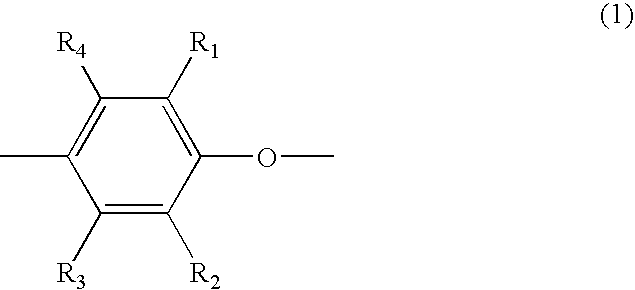Polyphenylene ether resin composition
a polyphenylene ether and resin technology, applied in the field of resin composition, can solve the problems of deterioration of chemical resistance, no compatibility with ppe, and lower the strength so as to improve the surface appearance of the molded article, improve the chemical resistance, and enhance the compatibility of components
- Summary
- Abstract
- Description
- Claims
- Application Information
AI Technical Summary
Benefits of technology
Problems solved by technology
Method used
Image
Examples
examples
[0078] Respective components were melt kneaded using a double-screw extruder (ZSK25 (L / D=46) manufactured by Werner & Pfleiderer) to obtain a resin composition. PPE and GPPS were supplied from a hopper of the extruder, and block copolymers and HIPS were added from a side feed opening provided at a position of L / D=15 or more. The temperature was set to 280° C., and the discharge rate was set to 15 to 25 kg. The evaluation results of resin compositions obtained are shown in Table 1 and Table 2.
TABLE 1(1)Example 1Example 2Example 3Example 4Example 5(A)PPE-19.759.759.759.759.75PPE-229.0329.0329.0329.0329.03HIPS12.0211.7719.2722.322.3GPPS33.232.8525.3524.3224.32(B)HTR-1552410HTR-2(C)HTR-3111114104HTR-4(D)α-Olefinic Copolymer0.60.60.60.6(E)PolyolefinState of SeparationGoodGoodGoodGoodGoodMFR [g / 10 min]1312.411.89.59.5HDT 18.3 MPa ° C.120121121119119IZOD [J / m]180183180252252FM [MPa]23502350235024002160Bending TestGoodGoodGoodGoodGoodSurface AppearanceSilver Streaks, Flow MarksGoodGoodGoo...
PUM
| Property | Measurement | Unit |
|---|---|---|
| molecular weight distribution | aaaaa | aaaaa |
| molecular weight distribution | aaaaa | aaaaa |
| particle size | aaaaa | aaaaa |
Abstract
Description
Claims
Application Information
 Login to View More
Login to View More - R&D Engineer
- R&D Manager
- IP Professional
- Industry Leading Data Capabilities
- Powerful AI technology
- Patent DNA Extraction
Browse by: Latest US Patents, China's latest patents, Technical Efficacy Thesaurus, Application Domain, Technology Topic, Popular Technical Reports.
© 2024 PatSnap. All rights reserved.Legal|Privacy policy|Modern Slavery Act Transparency Statement|Sitemap|About US| Contact US: help@patsnap.com








